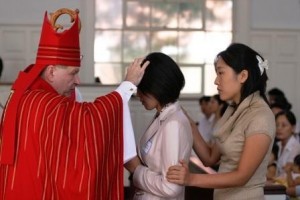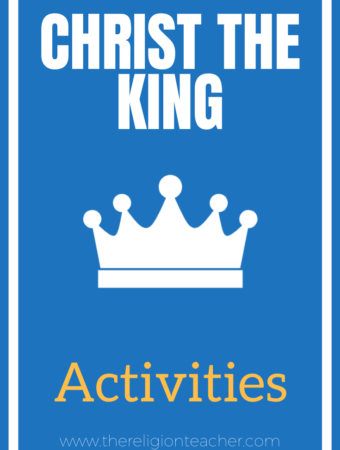According to the National Directory for Catechesis, there are two approaches to teaching ritual: the inductive method and the deductive method (NDC, 29). I wrote about these two approaches in a general way in a recent article published in the National Catholic Educational Association’s journal, Momemtum (February/March 2011, pp. 22-23). In the lesson plan below, I will apply the tips from that article to teaching the Rite of Confirmation using the deductive method. Later, I will post some tips for developing a post-Confirmation lesson plan using the inductive approach.
Catholic Confirmation Lesson Plan: Starting with Belief
Using the deductive method, catechists may begin with the beliefs and meaning of Confirmation and connect them with the ritual actions of the Sacrament. In this case, the meaning of Confirmation (though it is multi-layered) is the bestowal of the gifts of the Holy Spirit in a full and abundant way.
and connect them with the ritual actions of the Sacrament. In this case, the meaning of Confirmation (though it is multi-layered) is the bestowal of the gifts of the Holy Spirit in a full and abundant way.
Confirmation Lesson Objectives:
- SWBAT describe the key parts of the Sacrament of Confirmation.
- SWBAT act out the key parts of the Sacrament of Confirmation.
- SWBAT make connections between the meaning of the Sacrament of Confirmation and the Rite of Confirmation.
Confirmation Activities:
1. Summarize the essential meaning and effects of the Sacrament of Confirmation.
Draw from the textbook or catechetical resources that the students are using to ensure consistency. Based on the Catechism, the meaning and effects of the sacrament might include:
- We receive the fullness of the Holy Spirit (CCC, 1287), specifically receiving an increase of the Gifts of the Holy Spirit (CCC, 1303)
- Completes the Sacrament of Baptism (CCC, 1285, 1304), and therefore more firmly unites us with Christ, the Church, and God as our Father (CCC, 1303)
- We receive a special strength and character to witness, spread, and defend the Gospel (1303-1305)
(Be sure that Confirmation is seen as the completion, not the initial bestowal of these effects. Also, make sure that the sacrament is seen as more than the bestowal of the gifts of the Holy Spirit, which is the default answer for many Confirmation candidates. The clearer and simpler the effects and meaning, the easier it will be for students to make connections to the signs, symbols, and actions of the sacrament.)
You can also show the Sacrament of Confirmation Effects Video available to The Religion Teacher members. (Join here.)
2. Have students work in groups of 3-4 to create their own ritual actions that express these meanings and effects.
Remind the students that rituals are actions with deeper meaning. For instance, in Baptism water is used to express the deeper spiritual cleansing of sin. Have each group perform their rituals for the rest of the class. Make sure they designate one representative to explain how each of the rituals relate to the meaning of the Sacrament. Challenge them not to copy the rituals that they will learn or may already know from the actual Rite of Confirmation.
3. Using a textbook summary or video of the actual celebration of the Sacrament of Confirmation, summarize each key action that takes place.
Or consult the Catechism (CCC, 1293-1301) for a description of the signs and the celebration of the sacrament. Have students create a storyboard of each action (a picture of the action with a caption or word bubbles included). Note any similarities to the rituals they created themselves.
4. Review both the celebration of and the effects of the Sacrament of Confirmation by having the students list them on the board as Chalktalk.
Divide the board in two with one side labeled “Effects” and the other labeled “Celebration.” Give students the chalk or dry erase markers to list each sign, ritual, and effect on the board. Have them silently come to the board and write what they remember. Or if time is pressing, simply ask students at random to offer an effect or ritual and list it on the board.
5. Have the students create a simple cause and effect graphic organizer.
Note that each ritual and sign included in the Rite of Confirmation is not efficacious on its own, but must be included in the entire celebration. However, it is helpful to note how each sign and action connects with an effect or meaning of the sacrament. Give them the opportunity to make connections then review their work as a class. Their graphic organizers might looks like this:
| Sign/Action | Effect/Meaning |
|---|---|
| Renewing Baptismal Promises (CCC, 1298) | Confirmation completes the Sacrament of Baptism |
| Bishop Extends Hands in Blessing (CCC, 1299) | Outpouring of the Holy Spirit |
| Anointing with Oil (1293-1296) | receive the Holy Spirit, completes Baptism, united with Christ (the Anointed One, Messiah) |
| Laying on of Hands (1300) | Strength and character to witness to the Gospel |
| “Be Sealed with the Holy Spirit” (1300) | Indelible seal/character to witness; receive the gifts of the Holy Spirit |
Also available to members of The Religion Teacher: Sacrament of Confirmation Symbols Video.
Confirmation Assessments:
1. In the activities above, students learned about the Rite of Confirmation through writing, drawing, and acting out the signs and rituals of the Sacrament. As an assessment, have students list in writing or draw each key element of the Sacrament of Confirmation.
2. Then, have them work in groups to recreate and act out the Rite of Confirmation from memory (not using their notes). Correct each group if they make mistakes.
3. On a sheet of paper divided into two columns, have students list both the signs, symbols and actions on the left and the effects on the right. Have them draw arrows from a sign or ritual to the corresponding meaning and label the line with the reason why it connects.
(Image source: Aggie Catholic)
P.S. For additional resources to help you prepare students for Confirmation, check out this list of activities or use one of the many printables in The Religion Teacher’s Confirmation Worksheets.



Hi Jared,
This is really timely as I am looking for resource on how to discuss confirmation especially to youth not experiencing confirmation yet. Hope this excites them =) Many thanks and may God continue to sustain you more in sharing all this wisdom you’ve shared with all of us- co workers in Christ.
God bless!!!
You’re welcome, Wylene! I’m glad you found it so useful! Let me know how it goes.
Thank You Jared for all the effort you have put into this. I am so going to use all that I have learnt from here. God bless your endeavors.
hi jared.. im a christian living teacher here in the philippines.. and im really thankful to discover this site.. its really a big help for me… hope you continue this..God Bless you.
hi jared, i found your multiple notes and tutoring helpful in guiding our catechists/ religion teacher in our diocese. thank you so much for sharing your God given gifts and talents…
May our Good Lord bless you hundredfold more than you deserve…
God Bless.
in Him,
Joel
Dear Jared,
Thank you for sharing your giftedness. It helps me to improve my instruction. God bless!
Dear Jared, thank you for sharing. I have just started my journey as a Catechist and this book will definitely help me with my lessons planning.